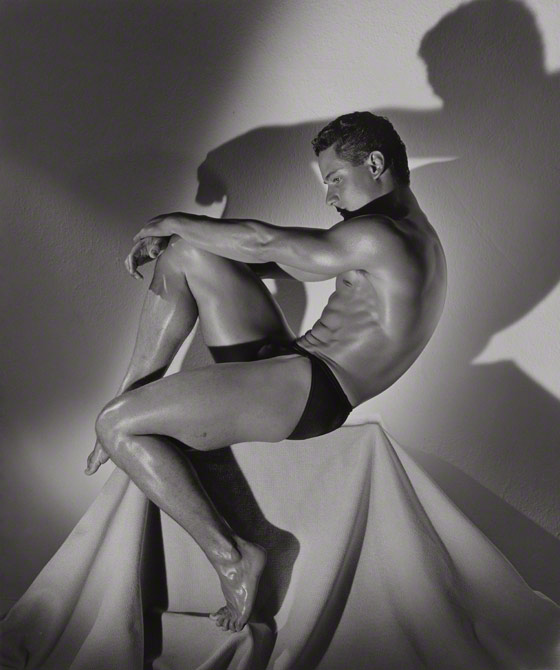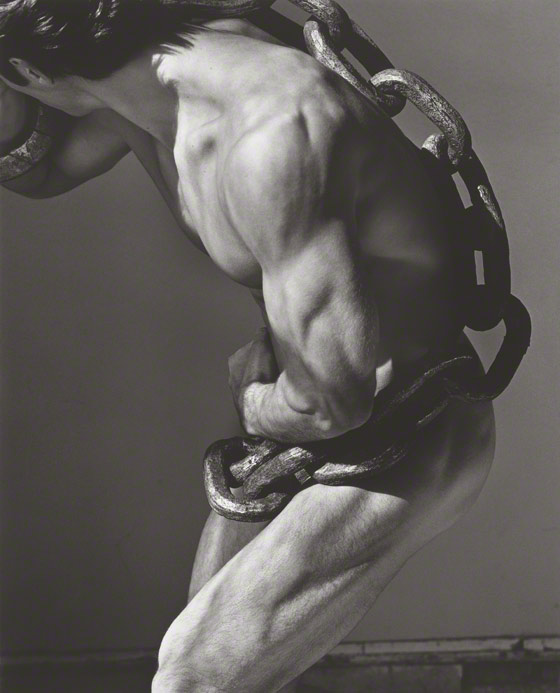
Greg Louganis, Hollywood, Herb Ritts, 1985. Gelatin silver print. © Herb Ritts Foundation
Chains. Pedestals. Balloons. Sea creatures. Those are just some of the props that photographer Herb Ritts employed to set a scene, adorn his models, and capture the viewer. The exhibition Herb Ritts: L.A. Style, on view through August 26, contains images that show how the artfully chosen and placed object can add to the glamorously attired—or nude—model’s allure.
Using props in photography was nothing new: fashion photographs had long been full of over-the-top costumes and symbol-laden props. But Ritts, the son of a furniture designer and interior designer, seemed to only employ objects that made everything look more chic.
“He liked to play with shapes and props,” said Mark McKenna, executive director of the Herb Ritts Foundation, who started out as Ritts’s camera assistant in 1989 and later became the executive producer for the photographer, managing his shoots. “It wasn’t every day, but if something visually pleased him, he felt it must be working.”
A simple fabric-draped pedestal in the image of Olympic champion swimmer Greg Louganis above gives the athlete the aura of 1940s movie star. In a previous post on The Iris, Nina Diamond shared McKenna’s story of how Ritts created a fashion icon with little more than fabric, poles, and wind.

Djimon with Octopus, Hollywood, Herb Ritts, 1989. Gelatin silver print. The J. Paul Getty Museum, Gift of the Herb Ritts Foundation. © Herb Ritts Foundation
The most unusual of Ritts’s props has to be the creature in the 1989 photograph Djimon with Octopus, Hollywood. The octopus is placed on the model’s bald head, its tentacles streaming down his face like exotic tresses. McKenna said that at the time there was a famous picture of a woman holding a shark against her body, and Ritts’s stylist, who had connections to local fishermen, turned up one day with the dead octopus.
“This was not done for shock value,” McKenna said. “It has a luminous quality to it…the slickness of the skin and the wetness highlight and reflect off each other.”
For Ritts, props had more than visual appeal. They gave his subjects a sense of being part of the craft and offered them something to react to, which often make them more at ease and spontaneous. For example, Ritts had bags of black and white weather balloons in his studio. The balloons, about five feet in diameter, were handy for models to play with and lean up against as the cameras clicked away. Even simple objects like these gave models and actors “something to play and work with,” McKenna said, “So they weren’t just standing there on the ‘X’ waiting for him to take a picture.”

Man with Chain, Los Angeles, Herb Ritts, 1985. Gelatin silver print. The J. Paul Getty Museum. © Herb Ritts Foundation
Case in point: Man With Chain. During the shoot, Ritts gave the nude model, Tony Ward, a massive chain (deceptively made of balsa wood, not metal) and let the muscular Ward play around with incorporating the prop into his twisted pose. The result is a godlike image of mythic struggle and one of Ritts’s most striking photographs.




Comments on this post are now closed.